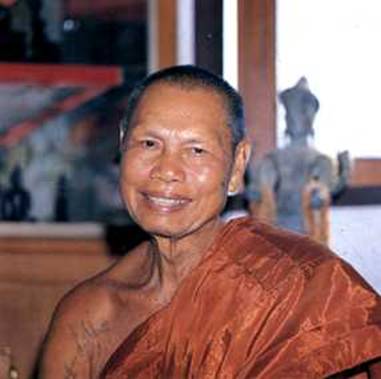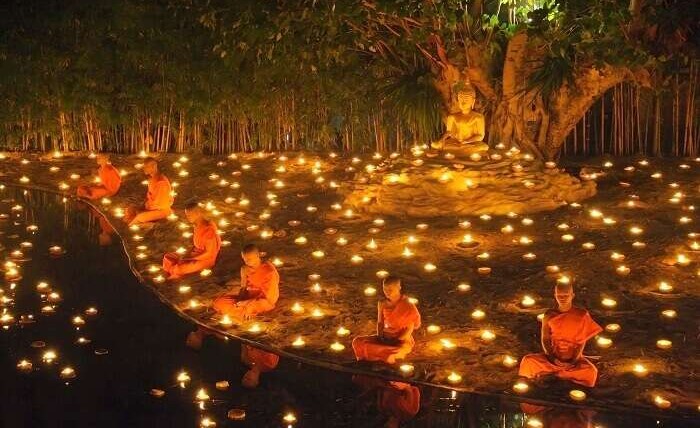Biography of most Venerable Luang Poo Sangwahn Khemako
Abbot of Wat Tungsammakeedhamm Suphanburi

Luang Puu Sangwan Khemako, birth name Sangwan Janrueang, was born on a Monday in March 1916 (the Year of the Big Snake) in Nong Pak Nak village, Supanburi Province. His father’s name was Mr. Huang and his mother’s Mrs. Wat. He was the third son of five children, as follows:
- Mr. Wut Janrueang
- Mr. Wet Janruenag
- Luang Puu Sangwan Khemako
- Phra (Monk) Somboon Jitawaro
- Mae Chi (Nun) Saibua Apidet
All the members in his family were rice farmers. He ordained as a monk for the first time at the age of 20. However, after 3 months, he was only able to recite two chanting verses because of his inability to read. So he disrobed and returned to farming.
In 1941, at the age of 25, he married Miss Bang. Not long afterwards he became ill and could not work in the rice fields. So his wife assumed the task of working in the rice fields while Luang Puu took over the task of preparing the food.
Luang Puu had endured much suffering due to a numbness disease that lasted two years. During that time he started to meditate with instruction from Mae Chi (Nun) Jintana, a follower of Luang Phor Sot at Wat Pak Nam, Phasicharoen, Bangkok. He meditated by following the changing conditions of his body and mind until he was able to free himself from the sickness that continually plagued him.
Later on there was a time when Mrs. Bang had become ill. Luang Puu helped take care of her much in the same manner as any ordinary husband would care for a sick and weak spouse. Mrs. Bang couldn’t look after herself and she wasn’t bathed for some time. So when he did bathe her, as he poured water over her head, the water began to evaporate and a foul-smelling vapor emitted forth. He began to have the highest compassion in that the bodies of all people are not pleasant, are nests of disease, and are the causes of suffering.
On another occasion, while Luang Puu walked past a large mirror that reflected a woman’s body, he saw her skeleton instead of her body. He realized that the body was always to be the best meditation teacher and as he practiced the knowledge arose in him of the conditions and causes of his mind and body, i.e. “self”. This allowed him to see the danger in all mental formations, particularly with his attachment to wife and family, and what manifested was a letting go of being bound to them. So Luang Puu told his wife of his unshakeable intention to follow the Dhamma-Vinaya of Lord Buddha for the complete cessation of suffering.
On the 25th of April 1951, at 2:45 in the afternoon, he ordained for the second time at Wat Nang Buat, Supanburi Province. Most Venerable Pra Kru Khaek was his preceptor. He received the Pali name “Khemako” [abode of tranquility]. In ordaining this time, Luang Puu intended to meditate and develop his mind by using strict training practices. He lived in the cemetery section of a forest temple named Wat Ban Tueng for 6 rainy seasons and was the disciple of Luang Phor Maha Thong Sobhano.
At Wat Ban Tueng he observed the following selected tudong (wandering) practices:
- Live in a cemetery daily.
- Go on alms round every day without fail.
- Eat only one meal per day.
- Not to accept any food after eating.
- Possess and use only a basic set of three robes daily.
Eventually he had to leave Wat Ban Tueng because of ‘appropriate improvements’ that had been made to the cemetery (it had been cleared out). So Luang Puu traveled to Wat Tung Samakkidhamm, located in the village of his birth, in order to please his parents and the laity who had invited him to stay there. Although Luang Puu had left the cemetery, he didn’t forsake his practice – not even a little bit. When we speak of this, we should reflect upon his words “meditators cannot discard their practice until they have taken their last breath”. He himself was an example of this. When he came to stay at Wat Tung he hoped to have the opportunity for solitary practice in order to progress smoothly in his meditation.
One day Luang Puu and others were meditating in an old temple building. Now because he was from this village, it was natural that some villagers wanted to test and to annoy him though for what reasons he didn’t know. One such male villager saw Luang Puu sitting in meditation and then took hold of his body and turned him as if he was sitting in a barber’s chair. Luang Puu recounted that he never felt angry toward that person, both at that moment and subsequently. He had stated, “A mind without anger naturally leads to happiness. Anger is akin to a spear that pierces a creature. So when an anger-less mind arises in one, where is it? It rests in bliss”. We assert that Luang Puu was a person who resided in the Dhamma and who possessed such a genuine happiness.
When Luang Puu first began to propagate the Dhamma, he faced many obstacles because most villagers didn’t understand his teachings. Some even committed unwholesome acts against him and obstructed all forms of propagation. He used to remark that one should work on behalf of Buddhist teachings; on behalf of the Buddha, the Dhamma, and the Sangha. Luang Puu never abandoned his Dhamma work and although he literally “turned the Wheel of Dhamma” by propagating alone, he never became frustrated.
In the end, Luang Puu had the ability to overcome the obstacles that he faced and he was able to spread the Dhamma to people far and wide who then became familiar with his teachings. He had stated “with compassion, I can wish that others attain to Nibbàna (liberation), and not walk the pathway to hell.” In addition, he had taught people to become accustomed with giving forgiveness: “whatever is spoken or done and continues to be is that person’s affair and not mine”. This is the way of a contented heart. Forgiveness is better than no forgiveness. With it there is no vindictiveness or enmity and it allows for strong wellness in body and mind.
Luang Puu had always used his bodily energy and mind power to follow and practice the teachings of the religion, even though the Buddha had reached Parinibbàna (state of liberation upon death) a long time ago. He strictly adhered to the Vinaya (monks’ discipline) training on a daily basis. He followed the daily regimen of a contemplative with the highest circumspection. He was and is most worthy of the praise and homage that has been bestowed upon him. He is a model for all generations.
Throughout the years his students had followed his guidance and acted with utmost respectfulness that bestowed many blessings upon them. He deservedly had the following that he did and we should all intimately reflect upon the following: Luang Puu was a forest master who deserved the highest praise and he was an exception to the mundane world. His superior knowledge and meticulous practice resonated through all his Dhamma expositions and they illustrated his complete mastery of the Dhamma. It would be difficult to find anyone today who could practice his daily tudong observances. He encountered the Dhamma and penetrated its truths while living in the forest cemetery for 6 years. He had seen that patience and restraint are the components of self-mastery and it is difficult to describe the complete restraint that he had over himself. The quality of his purity is worthy of the highest respect and adoration. [Luang Puu died on 2 June 2004 at Wat Sanghathan Temple, Nonthaburi.]
As the Blessed One has uttered:
“Påjà Ca Påja Nãyànaÿ Etammaÿ Gala Muttamaÿ”
“Paying Homage to Those Worthy of Homage is of the Highest Merit.”
Do not pierce or trample upon the hearts of others. Do not think of doing evil or causing destruction. The âcariyas (Noble Ones) are those who should be venerated. They are like the oars of a boat that are needed to cross to the other shore. May all generations remember them with devotion every day and night. Remembrance gives us the confidence that we will never abandon our teachers.


